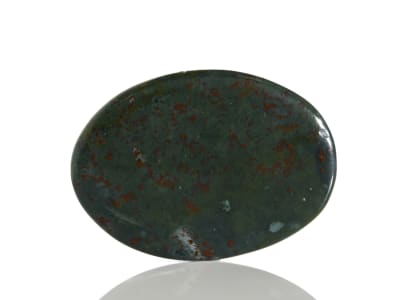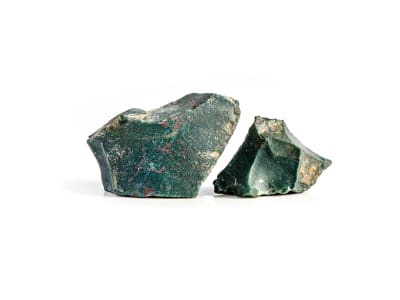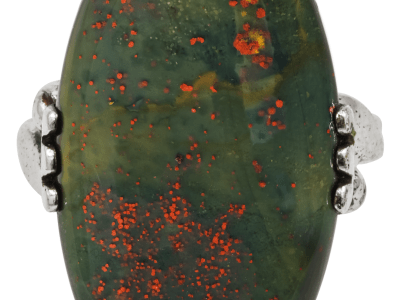Bloodstone is a forest green jasper with bright red spots of iron oxide probably hematite. The green color comes from amphibole, chlorite, and pyroxene inclusions in the chalcedony. The red spots are supposed to signify the blood of Christ. The stone is also known as heliotrope gets its name from Greek hḗlios (sun) and trépein (to turn). Bloodstone has been a favorite in ancient seals, signet rings and masculine jewelry. Most of the Bloodstone on the market today comes from India. It is one if the birthstones for March.
General Information
LWUV: Inert
Bloodstone Colors
-
 Green
Green -
 Multi-color
Multi-color
Alternate Names
Heliotrope
Countries of Origin
Russian Federation; Romania; Czechia; Uruguay; United States of America; Madagascar; United Kingdom of Great Britain and Northern Ireland; India; Canada; Unknown; China; Brazil; Italy; South Africa; Slovakia; Australia; Bulgaria; Germany
History
A First Dynasty of Ur bloodstone seal dates to 2900-2700 BCE. Five large bloodstone beads were found at the Royal Cemetery of Ur dating to 2150BCE-2000BCE. It is thought that the beads were manufactured in India. Numerous Roman intaglio signet rings featuring Roman gods and mythological creatures survive from the 1st and 2nd century Rome. A bloodstone engraving of a Kushan king on horseback dates to the 2nd and 3rd century. During the Middle Byzantine 843 to 1204 BCE cameos featuring Christian iconography were very popular. Several cameos featuring depictions of Christ, the Virgin Mary and various Saints have been found. Cameo carvings of Christ dating to the 16th century orient the red spots in the bloodstone to represent the crown of thorns. Decorative objects were carved in Italy, France, and Germany from bloodstone in the 15th and 16th centuries. Signet rings in Europe dating to the 16th and 17th centuries feature classical motifs, images of Christ, representations of heads in profile, and family crests. There are Islamic Seals dating to the Safavid dynasty 1691-1692BCE. All of these items can be found at The British Museum https://www.britishmuseum.org/.
Care
Normal Care
More About Bloodstone
Bloodstone has long been considered a magical stone and has been described in the writings of Pliny the Elder and Albertus Magnus (Saint Albert the Great). In Albertus Magnus “Book of Minerals” he says if the stone is crushed and put in a bowl of water it creates a flat surface to allow the viewer to observe solar eclipses. This legend is where the name heliotrope or sun turner comes from. He also reports a Babylonian legend that if the stone is rubbed with bloodstone root and then placed in water it will make the sun appear blood red and will create a mist that will fall like rain. George Frederick Kunz in his book “The Curious Lore of Precious Stones” relates the story that if bloodstone is fashioned with the shape of a bat that the wearer will have power over demons and it aides in performing spells. He also stated that it could stop hemorrhaging and nosebleeds. In Pitra’s “Lapidary of Damigeron” he states that the stone brings health and respect to the wearer and guards him from deception. The red spots on bloodstone are said to be symbolic of the blood of Christ. The stone is ground into a powder in India and used as an aphrodisiac.


